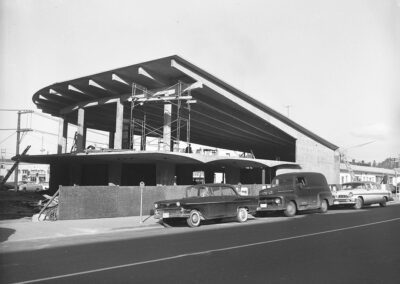
Gray, Victor O.
(1926 – 2016)
Noted engineer Victor Otto Gray was born on June 8, 1926 in Missoula, Montana. He grew up in Spokane and attended St. Aloysius and Gonzaga Prep. Upon graduation he was drafted and entered the Navy in 1943, serving in the SeaBees Corp. of Civil Engineers stationed in the South Pacific.
After the war, Gray returned to Spokane and earned a B.S. in Civil Engineering from Gonzaga University. He then continued his education at the University of Washington, receiving an M.S. in structural engineering in 1952. Upon graduation he worked for a variety of engineering firms including CED (1953), and Bruce C. Olsen Consulting (1957-58). With practical experience at hand, in 1959 Gray decided to open his own firm. Two years later in July of 1961, Daniel J. Evans joined the firm and the name was changed to Gray & Evans.
At the time, Evans was already serving as a State Legislator, and such position and its connections were good for the new firm which offered general consulting services to architects, contractors, manufacturers, and governmental agencies. Operating out of the 1411 Fourth Ave. in downtown Seattle, the firm specialized in civil and structural engineering as well as feasibility studies. building in downtown Seattle. At the time Gray had already made a name for himself having done the structural engineering work for the award-winning all-steel Benjamin Weeks House (1961, with architect Ibsen Nelsen) in West Seattle.
New projects for the young firm came in quickly and they included a wide variety of resource types, from industrial buildings to single family dwellings. Known projects included the futuristic Capital Savings & Loan Building in Olympia (1963, with Sibold & Nesland); a large parking garage in Boise for the Bon Marche (1963); a ground-breaking design for a new type of fire-lookout (constructed at Heybrook, on the Snoqualmie National Forest 1963); Seattle’s first condominium project, the Highlander (525 Belmont, 1965 with Ted LaCourse); the Dr. Thomas Morgan Jr. House (3434 Evergreen Pt., Medina); Green River College campus (1964); Lake Youngs Elementary School (1964 with Sullam & Alehle) in Kent; and a home by developer/builder D.H. Noonan that was constructed on pilings in the Magnolia neighborhood (1515 Magnolia Blvd, 1964, with architects John C. O’Brien, Evvian Willis and Hawley A. Dudley) of Seattle.
Evans’ interest in politics began in 1956 when he was elected to the Washington State House of Representatives, as a Republican. He campaigned on a platform that called for better roads, bridges, and “metropolitan planning.” Quiet and unassuming, he showed an early knack for forming bipartisan coalitions, a characteristic that would mark his entire tenure in politics. His fellow legislators voted him outstanding freshman. He was later elected GOP minority floor leader. Evans served in the Washington State House of Representatives from 1956 to 1965 before being elected governor. He served as governor from 1965 until 1977. In 1983, Governor John Spellman appointed Evans to the United States Senate to fill a seat left vacant by the death of longtime senator Henry M. “Scoop” Jackson. Evans won a special election later that year against Mike Lowry and filled the remainder of Jackson’s unexpired term, retiring from politics after the 1988 elections. He never returned to engineering and today lives in Seattle.
When Evans won the governorship in the fall election of 1964, he terminated his partnership with Gray. Gray continued the business under the name of Victor O. Gray & Associates (1965-87). By 1967 the firm had grown to 18 employees. Five staff members were moved to the level of associate in 1967. As the firm continued to flourish, Gray became known as a regional leader in his field and he became President of the Consulting Engineers Council, Washington Seattle Chapter, and National Vice President of the Consulting Engineers Council (CECW) of the U.S. In 1970 he was named Engineer of the Year by the CECW. In 2006 he was made Honorary Life Member in the Seattle Engineers Association and inducted into their Hall of Fame.
In 1987 Gray sold his company to Entranco Engineers but continued working there as Associate Engineer, heading their Structural Engineering Department until his semi-retirement in 1992. He passed away on May 9, 2016 at the age of 89.
Gray’s notable later projects include: the rehab of the Legislative Building in Olympia; Arnold Medical Pavilion; Freeway Park Garage; SeaTac Airport Terminal; the Mercer Island Floating Bridge; the Ambaum Shopping Center (1966 with Chester Lindsay); Seattle First National Bank – Broadway Branch (1965 with Sullam & Aehle); the Bon Marche Distribution Center (1967); the award-winning Blake, Moffitt & Towne warehouse (1970 with Bittman, Sanders & Hasson); Flaming Geyser Bridge; KCTS 9 Tower; multiple buildings at UW, WWU, and CWU; Olympic Memorial Hospital; the Robbins Company Building in Kent (1977 with Hewitt-Daly); and the Holy Names Academy building. Over the course of his career this work totaled nearly 800 projects.
– Michael C. Houser
Washington State Department of Transportation Building | Olympia
Built 1970 | Source: Washington State Archives
The Highlander Condominium (left) and Lamplighter Apartment (right) | Seattle
Built 1965 & 1962 | Source: DAHP
The Highlander Condominium (right) and Lamplighter Apartment (left) | Seattle
Built 1962 & 1965 | Source: DAHP







